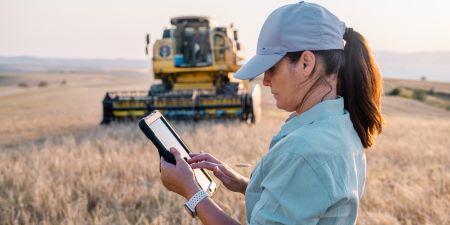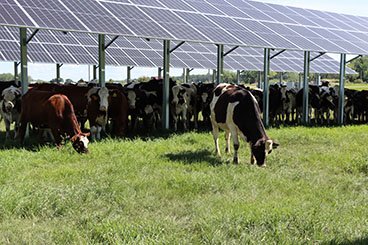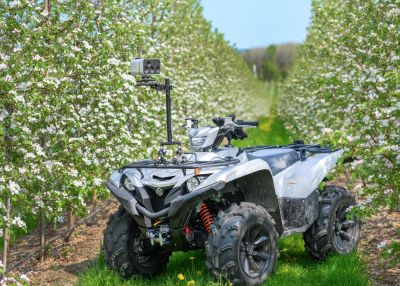Canada’s agri-food sector needs to accelerate adoption of innovative technologies
 Canada’s agri-food sector must step up its use of advanced technologies to achieve the expected 68-per-cent increase in global food production needed by 2050, experts told Alberta Innovates’ Inventures event in Calgary.
Canada’s agri-food sector must step up its use of advanced technologies to achieve the expected 68-per-cent increase in global food production needed by 2050, experts told Alberta Innovates’ Inventures event in Calgary.
The transformation of farms – and of farmers themselves – has already begun. But it will need to accelerate to ensure Canadians have food security and safety, and the country’s agri-food industry can compete internationally, panelists said at a session titled, “Farming Futures: New Innovations to Feed a Growing Global Population.”
So-called “smart farming” includes deploying remote sensing devices in agricultural equipment such as tractors, planters, crop sprayers and combines in the grain and oilseed industries, and in robotic milkers and ear tags in the dairy, beef, swine and poultry industries.
The smart sensing devices transfer data from the implement or animal to computers that then use artificial intelligence and machine learning to provide real-time guidance and controls back to the implement and/or operator.
 However, much of this so-called “small data” now stops at the farm gate and isn’t integrated and analyzed with other types of much larger databases in a “big data” approach, Erik Westblom (photo at right), founder and CEO at Provision Analytics, told Inventures. The Calgary-based company builds software technology to digitize all aspects of food safety.
However, much of this so-called “small data” now stops at the farm gate and isn’t integrated and analyzed with other types of much larger databases in a “big data” approach, Erik Westblom (photo at right), founder and CEO at Provision Analytics, told Inventures. The Calgary-based company builds software technology to digitize all aspects of food safety.
Data on agricultural inputs “don’t go into the food supply chain for choices and decision-making on how best to optimize raw material,” he said.
For example, 30 to 40 per cent of the world’s pulse crops, such as lentils, dry peas, chick peas and dry beans, are grown in Canada and get shipped all over the world. Canada is the world’s No. producer of lentils and dry peas.
But Westblom said that all the existing data available on production of pulse crops could be digitized, integrated and analyzed, and then be used by Canadian food processors to produce more value-added products within Canada from these now-exported commodity crops.
Ingredient manufacturing, food processing and bio-products represent a $25-billion-a-year opportunity for Canada, according to the Regina-based, federally funded Protein Industries Canada global innovation cluster
Westblom said when it comes to utilizing big data, reliable traceability of crops and agri-food products is coming to Canada’s agri-food sector – but it’s not here yet. Such traceability will require using unified data markers, data sets with aligned standards, and data serialization throughout supply chains.
In North America, new regulations from the U.S. Food and Drug Administration are driving the implementation of this sort of rigorous traceability, Westblom said.
What is happening now in agriculture and food production is the start of digitization of crop, livestock and food production data, he added. “There’s so little true computer science or technology adoption, outside of heavy equipment.”
Why heavy equipment? Throughout North America, baby boomers are retiring from farming and their relatively small and medium-sized farms are being consolidated into ever-bigger farms.
Some of these “juggernaut” operations, as Westblom described them, are now using autonomous combine harvesting machines with a 60-foot-wide (just over 18 metres) header. The header is the platform with a reciprocating cutter bar and a revolving reel with metal teeth to cause the cut crop to fall into the auger.
By 2050, Westblom said, innovation will have produced some autonomous combines – all driven by satellite global positioning systems – that have enormous 100- to 200-foot-wide (30 to 60 metres) headers.
Artificial intelligence will be used in everything from seeding to combining and downstream in food production, he predicted.
Robots are coming
 Along with AI, “robots are coming,” said Kiju Lee (photo at left), associate professor, engineering technology & industrial distribution and mechanical engineering, at Texas A&M University.
Along with AI, “robots are coming,” said Kiju Lee (photo at left), associate professor, engineering technology & industrial distribution and mechanical engineering, at Texas A&M University.
Lee, whose research focuses on developing small autonomous robots – called “swarm robots” – pointed out that huge autonomous machines can cause soil compaction and are often unsuitable or impractical for smaller and mid-sized farms.
But those farmers could use a combination of small aerial and ground robots to map their fields, monitor the rows of crops for signs of weeds and pests, and deliver treatments to those specific locations, she said. Swarm robots also could tackle jobs that are tedious, difficult or risky for farmers.
The robots are individually autonomous, so if one or two break down or are hit by a cybersecurity attack, the remaining robots will continue to do their tasks, Lee noted.
Swarm robots enable the scalability, flexible integration and customized operations needed for individual farms that are very different from each other even when growing the same crop, she said.
However, surveys show the adoption rate of robots by U.S. farmers was zero per cent in 2019, and by 2022 had reached only three per cent.
Barriers to adoption include robots being not readily accessible to farmers, being too expensive (although their cost is dropping), and farmers having no knowledge or training on how to troubleshoot problems and maintain the robots, Lee said.
Society needs to consider human factors in designing robots, including the human end-users of the machines, she said.
Lee said her research group is involving farmers in the robot design process, including doing focus groups and workshops with farmers to understand their needs and learning curves.
Many researchers are working on developing robots for harvesting, where the robots’ physical actions present very challenging components, she said. “We’ll see more of them in the fields within the next five to 10 years, replacing the humans doing the harvesting jobs.”
Increasing technology adoption by farmers
Another barrier to digital technology adoption is that many farmers mistrust agricultural technology providers (ATPs), care about who benefits from the use of aggregated data, and don’t want to share data they consider their asset, according to a study by the Johnson Shoyama Graduate School of Public Policy, and the Canadian Centre for the Study of Co-operatives at the University of Saskatchewan.
One possible solution is to create ag data co-operatives, similar to co-operatives that farmers have used since the late 1800s, the study said.
The governance structure in an ATP co-op – one in which farmers own the ag data service provider with which they do business – would act to ensure that farmers’ data are not exploited. In addition to providing farmers with the full benefit of the data they own, an ag data co-operative would provide farmers with the trust needed to adopt big ag data.
Government and academia also play vital roles in working with industry and educating farmers about new technologies and encouraging their adoption.
British Columbia’s On-Farm Technology Adoption Program, funded through the Sustainable Canadian Agricultural Partnership, is helping farmers adopt new technology such as automation, robotics and innovative growing, packing and storage solutions.
For example, in the Fraser Valley, Van Eekelen Enterprises Ltd. bought a robotic weeder for its field vegetables. The “Robot One” is a machine learning platform that can be taught by the operator’s input to differentiate between weeds and crops. After identifying weeds, the machine can selectively kill the weeds with a variety of tools on the machine.
Sandhar Farms in Kelowna bought a fruit-picking platform for its orchard. This technology, rarely seen in B.C.’s agricultural sector, lifts workers to the height of the fruit, thereby eliminating the need for ladders and significantly enhancing safety and working conditions. The technology also reduces damage to the fruit as apples are placed gently in the bin.
Camirlaney Farms in Delta, B.C. received funding to upgrade its potato storage with computer panels and digital sensors to control the storage temperature, which will decrease crop damage and loss from moisture and decay.
In New Brunswick, a new $1.5-million partnership this month announced the creation of a chair in digital agriculture at the University of New Brunswick (UNB). The provincial Department of Agriculture, Aquaculture and Fisheries is contributing $240,000 in the partnership. McCain Foods will contribute $760,000 and ResearchNB will provide $500,000.
Additional funds from the McKenna Institute and McCain Foods will be dedicated to the development of digital agriculture at UNB.
In Alberta, the University of Calgary officially launched the Alberta Digitalization Agriculture program in April this year. The program is supported by a $1.2-million provincial government grant to the Simpson Centre for Food and Agricultural Policy at UCalgary’s School of Public Policy.
The aim of the three-year program is to help producers and policymakers develop ideas that will increase the adoption of agricultural digital technologies. The program focuses on leveraging advancements in robotics, artificial intelligence and smart devices to transform the agricultural landscape.
Integrating agriculture and solar energy
Another technology that’s changing agricultural production in Canada is distributed and renewable energy, including solar-generated electricity and energy storage.
 Jon Bichel (photo at left), chief operating officer at Solartility, is working with University of Calgary scientists on developing an agri-voltaics model suitable for Alberta’s three million-plus acres used for cattle grazing by about 18,000 ranching operations.
Jon Bichel (photo at left), chief operating officer at Solartility, is working with University of Calgary scientists on developing an agri-voltaics model suitable for Alberta’s three million-plus acres used for cattle grazing by about 18,000 ranching operations.
The project, which received $3.1 million from Emissions Reduction Alberta, aims to establish an agri-voltaics research facility at W.A. Ranches. The 19,000-acre ranch in the foothills west of Calgary was donated to UCalgary in 2018 for teaching and learning purposes.
Bichel told the Inventures audience that one goal of the new agri-voltaics model is to minimize the agricultural land area lost to solar power installations. For example, solar panels can be mounted with a vertical racking system on piles, above the height of cattle, allowing them to graze beneath the panels.
Raised panels also act like a canopy, creating a micro-climate underneath the solar array that provides wind-blocking and shade for the cattle and also can enhance moisture retention and improve the productivity of certain crops.
The agri-voltaics system is being designed to be modular, scalable and cost-competitive, so it can be readily deployed on small farms as well as huge utility-scale farms, Bichel said.
Biotech will have big impact on farming and food production
 Biotechnology and bioproducts derived from natural resources will significantly change how farming and food production is done by 2050, said Sumit Verma (photo at right), co-founder and CEO at Halifax-based Reazent, which is developing high-efficacy organic alternatives to replace agrichemicals that have environmental impacts.
Biotechnology and bioproducts derived from natural resources will significantly change how farming and food production is done by 2050, said Sumit Verma (photo at right), co-founder and CEO at Halifax-based Reazent, which is developing high-efficacy organic alternatives to replace agrichemicals that have environmental impacts.
For example, ammonia fertilizer used on farms contributes about 500 million tonnes globally of carbon dioxide, the main greenhouse gas (GHG) responsible for global warming. Worldwide, the food system accounts for 26 per cent of total GHG emissions.
Verma said his company has found a way to replace ammonia fertilizer with microbes that can fix the nitrogen needed and used by crop plants, at the time the plants need the nutrient.
“We are not 100-per-cent there [with the technology], but we’re getting there,” he said.
The adoption by farmers of bio-based technologies has been very slow, Verma noted. Farmers have said they require two things from such technologies: 1) high efficacy; and 2) consistent performance across soil types, weather conditions and varying farm environments.
“Until bio-based products achieve these two objectives, they’re not going to be adopted by these farmers,” Verma said. “But we are making progress.”
One-third of croplands worldwide are actually used to grow feed for livestock rather than humans. Verma pointed out that only about 1.5 per cent of the world’s agricultural operations are organic, while the remainder consists of conventional agriculture which includes using agrichemicals.
Until organic agriculture catches up with conventional agriculture in terms of efficacy, consistent performance and productivity, growers need to be incentivized to adopt organic agriculture because it benefits the environment and society, he said.
Verma suggested such incentives could include farmers receiving tradeable carbon credits for producing fewer GHG emissions, as well as government financial incentives for shifting to organic agriculture – similar to incentives the electric vehicles industry and consumers buying EVs receive.
Consumers also need incentives to buy higher-priced, premium quality products such as organic produce until technological advancements and adoption can level the playing field between organic and conventional agriculture, Verma said.
The future is always unpredictable. But Lee from Texas A&M University said it is certain that “what farmers will be doing in the future will be very different,” and they will need to get the knowledge, training and skills-set required to operate a farm in 2050.
R$
Events For Leaders in
Science, Tech, Innovation, and Policy
Discuss and learn from those in the know at our virtual and in-person events.
See Upcoming Events
You have 0 free articles remaining.
Don't miss out - start your free trial today.
Start your FREE trial Already a member? Log in
By using this website, you agree to our use of cookies. We use cookies to provide you with a great experience and to help our website run effectively in accordance with our Privacy Policy and Terms of Service.



.png)

